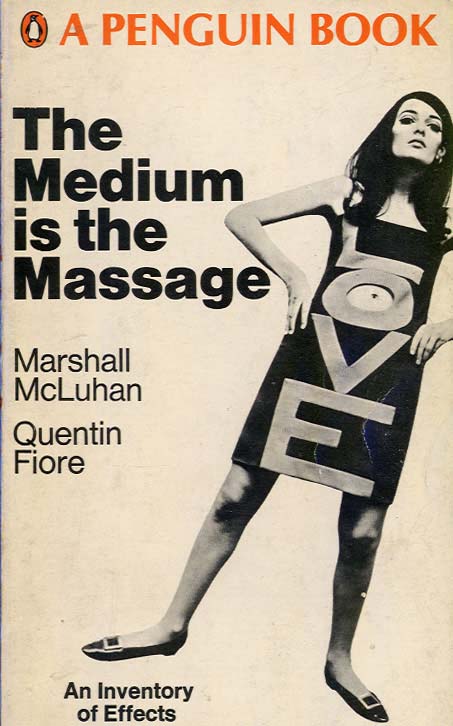

short explanations of key terms of McLuhan's thinking
(all quotes mentioned here from wikipedia)
pop culture
the medium is the message
"[I]f a new technology extends one or more of our senses outside us into the social world, then new ratios among all of our senses will occur in that particular culture. It is comparable to what happens when a new note is added to a melody. And when the sense ratios alter in any culture then what had appeared lucid before may suddenly become opaque, and what had been vague or opaque will become translucent."
--> media are extension of men
--> media have the capacity to environ
--> media form and shape infrastructures
--> media shape environments
--> media have social impact
--> media change social interactions
--> the message is not the content delivered by new media, but the structuring capacities of the media, the medium is the message
--> new media have effects on cognition, which continues to affect social organization
--> society affected by the characteristics of the medium itself
example: light bulbs enabled us to create new spaces in the dark
“The medium, or process, of our time - electric technology is reshaping and restructuring patterns of social interdependence and every aspect of our personal life.
It is forcing us to reconsider and re-evaluate practically every thought, every action, and every institution formerly taken for granted.
Everything is changing: you, your family, your education, your neighborhood, your job, your government, your relation to “the others”.
And they’re changing dramatically.”
--> unintended consequences
--> change of schale, pace or pattern that medium has on human affairs --> change in social dynamics --> medium is anything that can initiate change
--> retribalizing, away from individualism
--> everyone everyone in the world gets the same message
--> media work through our senses
--> the way in which we see, feel,... changes with the change of media
--> from industrial/postindustrial times to information age
concept gets clearer when you compare the characteristics of the gutenberg-age and the time of the global village:
the gutenberg galaxy
--> linear, serial
--> print, assembly line
--> predominance of the visual over the aural
--> books first teaching machine
global village
--> parallelity, synchronicity, field not line
--> no center, every place becomes a center
--> electronic nervous system as a common metaphor
--> electronic age will shift from visual to aural culture, from individualism to collectivity
"Instead of tending towards a vast Alexandrian library the world has become a computer, an electronic brain, exactly as an infantile piece of science fiction. And as our senses have gone outside us, Big Brother goes inside. So, unless aware of this dynamic, we shall at once move into a phase of panic terrors, exactly befitting a small world of tribal drums, total interdependence, and superimposed co-existence. [...] Terror is the normal state of any oral society, for in it everything affects everything all the time. [...] In our long striving to recover for the Western world a unity of sensibility and of thought and feeling we have no more been prepared to accept the tribal consequences of such unity than we were ready for the fragmentation of the human psyche by print culture"
hot and cool media
hot: high level of involvement of the user, low level of stimulance/participation; examples: a lecture, radio, film; sequential, linear, logical; emphasize one sense
cool: low level of involvement of the user, high level of stimulance/participation; examples: a seminar, comics, TV
their connection not dichotomous, but continous,
"There is a basic principle that distinguish a hot medium like radio from a cool one like the telephone, or a hot medium like the movie from a cool one like TV. A hot medium is one that extends one single sense in "high definition." High definition is the state of being well filled with data. A photograph is, visually, "high definition." A cartoon is "low definition," simply because very little visual information is provided. Telephone is a cool medium, or one of low definition, because the ear is given a meager amount of information. And speech is a cool medium of low definition, because so little is given and so much has to be filled in by the listener. On the other hand, hot media do not leave so much to be filled in or completed by the audience. Hot media are, therefore. low in participation, and cool media are high in participation or completion by the audience. Naturally, therefore, a hot medium like radio has very different effects on the user from a cool medium like the telephone."
--> one to many vs many to many
tetrad of media effects:
- What does the medium enhance?
- What does the medium make obsolete?
- What does the medium retrieve that had been obsolesced earlier?
- What does the medium flip into when pushed to extremes?
TV-interview on the CBC archives:
http://archives.cbc.ca/arts_entertainment/media/clips/1814/
McLuhan publications online:
--> "Understanding Media: the Extensions of Men" (1964):
http://cultofjim.com/scripture/understanding_media/
--> "The Medium is the Massage", audio-recording from 1967, on ubuweb:
http://ubu.artmob.ca/sound/mcluhan_marshall/Mcluhan-Marshall_The-Medium-Is-The-Massage_01.mp3 and
http://ubu.artmob.ca/sound/mcluhan_marshall/Mcluhan-Marshall_The-Medium-Is-The-Massage_02.mp3
--> "The Medium is the Massage", 1967:
Marshall McLuhan - The Medium is the Massage
youtube playlist of McLuhan videos:



